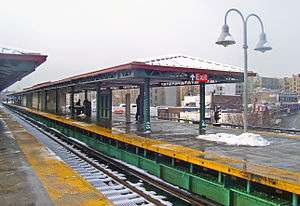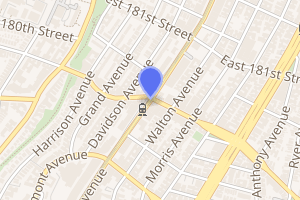Burnside Avenue station
Burnside Avenue is an express station on the IRT Jerome Avenue Line of the New York City Subway. Located at the intersection of Burnside and Jerome Avenues in the Bronx, it is served by the 4 train at all times.
Burnside Avenue | |||||||
|---|---|---|---|---|---|---|---|
 View south from northbound platform | |||||||
| Station statistics | |||||||
| Address | Burnside Avenue & Jerome Avenue Bronx, NY 10453 | ||||||
| Borough | The Bronx | ||||||
| Locale | Morris Heights, University Heights | ||||||
| Coordinates | 40.853748°N 73.90739°W | ||||||
| Division | A (IRT) | ||||||
| Line | IRT Jerome Avenue Line | ||||||
| Services | 4 | ||||||
| Transit connections | |||||||
| Structure | Elevated | ||||||
| Platforms | 2 island platforms cross-platform interchange | ||||||
| Tracks | 3 | ||||||
| Other information | |||||||
| Opened | June 2, 1917 | ||||||
| Station code | 384[1] | ||||||
| Accessible | not ADA-accessible; accessibility planned | ||||||
| Opposite-direction transfer available | Yes | ||||||
| Former/other names | Burnside Avenue–180th Street Burnside Avenue–New York University | ||||||
| Traffic | |||||||
| Passengers (2019) | 3,113,514[2] | ||||||
| Rank | 161 out of 424[2] | ||||||
| Station succession | |||||||
| Next north | Woodlawn (express): no regular service 183rd Street (local): 4 | ||||||
| Next south | 176th Street (local): 4 149th Street–Grand Concourse (express): no regular service | ||||||
| |||||||
| |||||||
| |||||||
It also serves as a rush hour short turn northern terminal for select 4 trains from Crown Heights–Utica Avenue; they usually arrive at the Woodlawn bound platform on the express track and then run to the Mosholu Yard.
History
Burnside Avenue first opened as Burnside Avenue–New York University on June 2, 1917. New York University had a Bronx campus located northwest of the station; the neighborhood that developed there became known as University Heights before NYU sold its campus to the City University of New York in 1973. CUNY then acquired it to be used for the Bronx Community College, which would move its operations from the former Bronx High School of Science, located at Creston Avenue and 184th Street, during the Fall semester of that year to the NYU Bronx campus.[3] A year after the acquisition, in 1974, the station was renamed to Burnside Avenue–180th Street because 180th Street was used as another name for Burnside Avenue at the time. It would further be renamed Burnside Avenue in 1979.[4]
In 1981, the Metropolitan Transportation Authority listed the station as one of 69 stations in dire need of renovation.[5] The report prompted an early renovation that continued until 1985.[6] Among the things that were done to the station during that time included a painted orange platform edge in addition to the yellow platform edge that was originally on each platform. New, corrugated signposts were installed and spaced evenly on the platform; these bore the station name in white lettering against a black metal sign (the font used for the signs was Akzidenz-Grotesk; it was first used as the agency's font prior to renovation).[7]
The fencing around the entrances to the platforms from the mezzanine were painted black while the rest of the platforms, including a few mushroom shaped incandescent lampposts that were installed during the renovation and the fences around each of the four entrances, were painted red; most of the lampposts bore the 180th Street name. The original hand rails, as well as the original iron maidens were also painted yellow. Two fences that were at the south end of each platform retained their paint color; the one on the Woodlawn bound platform would later be replaced with a second Communication Room.[8]
As early as September 8, 1996, the 180th Street name began to be retired on the uncovered parts of each platform by replacing the mushroom shaped incandescent lampposts with unpainted sodium vapor lampposts.[9] By 1999, all of the lights in those areas were sodium vapor lampposts, but the footprints for the original location of the original lampposts still remain.[10]
This station was renovated a second time from June 17 to October 16, 2006 as part of a $55 million project to renovate five stations (183rd Street, Kingsbridge Road, Bedford Park Boulevard and Mosholu Parkway being the other four) on the IRT Jerome Avenue Line, bringing them to a State of Good Repair.[11][12] During this time, the mezzanine area and staircases received a facelift, while both platform canopies and the structural beams that hold each canopy were replaced and yellow tactile edge warning strips were installed. Also, the token booth in the mezzanine was reduced in size and relocated from directly facing the main turnstiles from the unpaid side of fare control to facing the Manhattan bound stairs from behind the Woodlawn bound stairs, also from the unpaid side of fare control.
In 2019, the MTA announced that this station would become ADA-accessible as part of the agency's 2020–2024 Capital Program.[13]
Station layout
| P Platform level |
Northbound local | ← |
| Island platform | ||
| Peak-direction express | ← (No express service: Woodlawn or 149th Street–Grand Concourse) | |
| Island platform | ||
| Southbound local | | |
| M | Mezzanine | Fare control, station agent |
| G | Street level | Exit/entrance |
Burnside Avenue is the only express station (with three tracks and two island platforms) on the elevated portion of the Jerome Avenue Line. The only other express station on the Jerome Avenue Line is the underground 149th Street–Grand Concourse station.
The 2008 artwork here is called How to Get to the Moon by Laura Battle, which speaks about the relationship between the sun and moon as well as day and night.[14]
Exits
Four exits lead from the mezzanine to either southern corner of Burnside and Jerome Avenues (two to each corner). There are extra side exits from the wooden mezzanine near the stairs to the platform, and the station is three to four stories above street level.[15]
References
- "Station Developers' Information". Metropolitan Transportation Authority. Retrieved June 13, 2017.
- "Facts and Figures: Annual Subway Ridership 2014–2019". Metropolitan Transportation Authority. 2020. Retrieved May 26, 2020.
- "History & Architecture - Bronx Community College". Bronx Community College. Bronx Community College. Retrieved April 7, 2019.
- Grotjahn, Douglas (November 17, 1979). "Low Voltage 4 train in fantrip (with station sign)". www.nycsubway.org. Burnside Avenue: www.nycsubway.org. Retrieved October 14, 2016.
- Gargan, Edward (June 11, 1981). "Agency Lists Its 69 Most Deteriorated Stations". The New York Times. ISSN 0362-4331. Retrieved October 14, 2016.
- Goldman, Ari L. (April 28, 1983). "M.T.A. Making Major Addition to Capital Program". The New York Times. ISSN 0362-4331. Retrieved October 14, 2016.
- Eisenpress, Aron (November 17, 1979). "Akzidenz Grotesk font at Burnside Avenue". nycsubway.org. Burnside Avenue: nycsubway.org. Retrieved April 7, 2019.
- Cox, Jeremiah (December 19, 2003). "Looking south towards the Woodlawn bound platform, with the Communication Room in the background". SubwayNut. Burnside Avenue: SubwayNut. Retrieved April 7, 2019.
- Pirmann, David (September 8, 1996). "4 train arriving at Burnside Avenue with mushroom incandescent lampposts and new sodium vapor lampposts". www.nycsubway.org. www.nycsubway.org. Retrieved October 14, 2016.
- Pirmann, David (December 5, 1999). "4 train leaving Burnside Avenue with sodium vapor lampposts on platform". www.nycsubway.org. Burnside Avenue: www.nycsubway.org. Retrieved October 14, 2016.
- "Mosholu Station to Close October 30 for renovation". Norwood News. Norwood News. October 19, 2006. Retrieved October 14, 2016.
- "Press Release about Renovation". www.mta.info. www.mta.info. March 5, 2007. Retrieved October 14, 2016.
- "Press Release - MTA Headquarters - MTA Announces 20 Additional Subway Stations to Receive Accessibility Improvements Under Proposed 2020-2024 Capital Plan". MTA. December 19, 2019. Retrieved December 25, 2019.
- Battle, Laura (2008). "www.nycsubway.org: Artwork: How to Get to the Moon (Laura Battle)". www.nycsubway.org. www.nycsubway.org. Retrieved October 14, 2016.
- "Burnside Avenue Neighborhood Map" (PDF). new.mta.info. Metropolitan Transportation Authority. April 2018. Retrieved February 28, 2019.
External links

- nycsubway.org – IRT Woodlawn Line: Burnside Avenue
- nycsubway.org — How to Get to the Moon Artwork by Laura Battle (2006)
- Station Reporter — 4 Train
- The Subway Nut — Burnside Avenue Pictures
- MTA's Arts For Transit — Burnside Avenue (IRT Jerome Avenue Line)
- Burnside Avenue entrance from Google Maps Street View
- Platforms from Google Maps Street View



